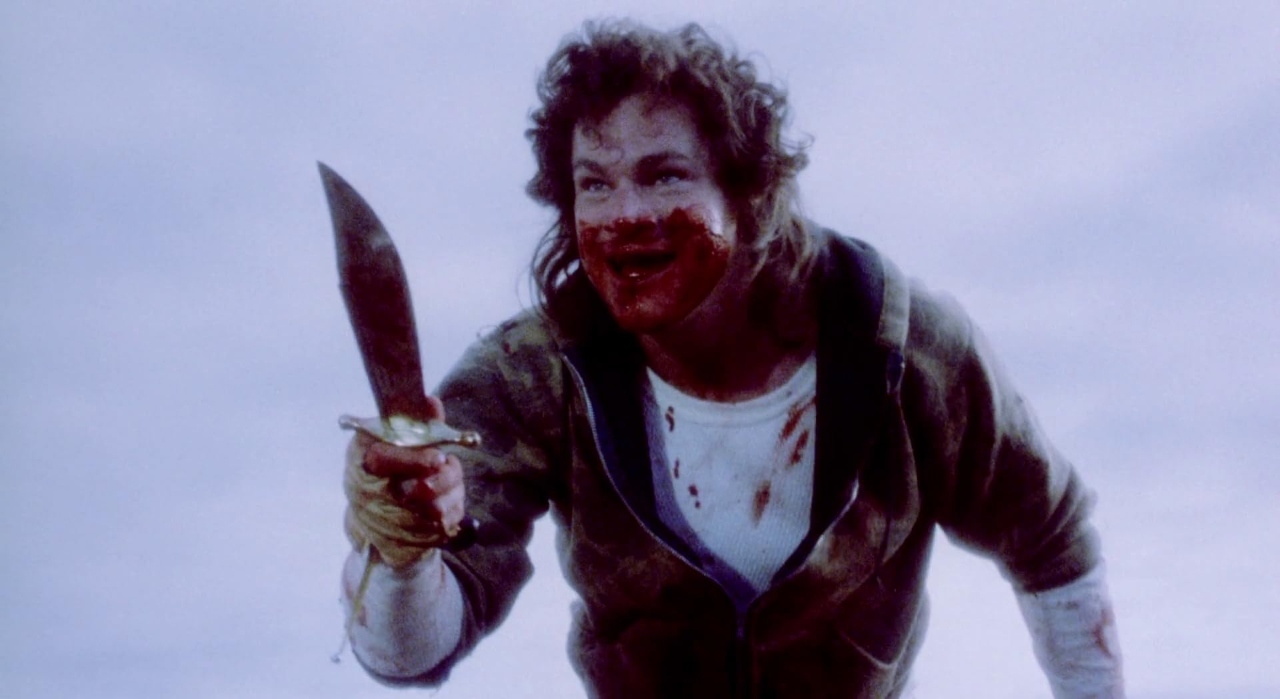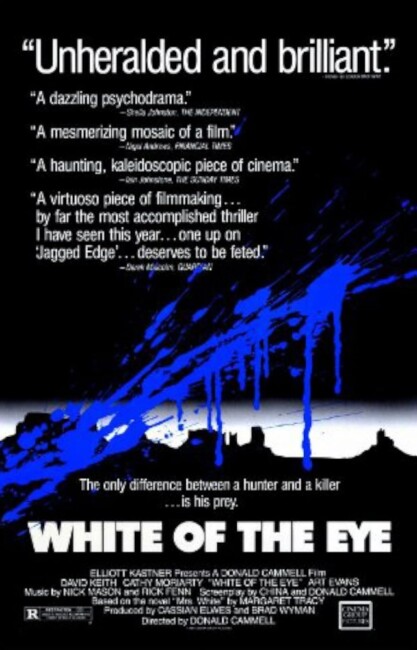Crew
Director – Donald Cammell, Screenplay – China Cammell & Donald Cammell, Producer – Elliott Kastner, Photography – Larry McConkey, Music – Nick Mason & Rick Penn, Production Design – Philip Thomas. Production Company – Mrs White’s Productions.
Cast
David Keith (Paul White), Cathy Moriarty (Joan White), Alan Rosenberg (Mike Desantes), Danielle Smith (Danielle White), Art Evans (Detective Mendoza), Alberta Hunter (Ann Mason)
Plot
A number of women have been murdered across Arizona in strange ritualistic ways that are reminiscent of American Indian ceremonies. After the latest killing in the town of Globe, police find the tracks of a specially imported tire at the scene, of which there are only twenty in the entire state. Their investigation takes them to custom stereo designer Paul White, an average, sane, happily married man, who seems far too normal to possibly be a suspect. However, Paul’s wife Joan then begins to find evidence that makes her doubt that.
Cammell’s career since then was an exceedingly sporadic one. He had an enormous number of ideas, many of which were optioned over the years – he was even championed to write projects and novels by Marlon Brando – but refused to compromise these ideas and as a result found difficulty getting financing. Cammell had one dalliance with studio filmmaking – the rapist computer science-fiction film Demon Seed (1977), which proved a disastrous experience where the studio attempted to take over editing of the film without Cammell’s say-so.
Cammell’s next venture back behind the camera was with White of the Eye, a film that never managed to get the distribution and profile it deserved to. Cammell would make one other film, the erotic thriller Wild Side (1995), which again suffered from edits imposed on him by the production company (Nu Image) who tried to force Cammell to pump up the erotic content and released a butchered cut that curtailed Cammell’s more arty predilections.
It is believed it was the unhappy experience of Wild Side that drove Cammell to commit suicide by self-inflicted gunshot wound in 1996. The story of Cammell’s tempestuous career and some glimpse of his undeniable but sadly unfulfilled brilliance can be seen in the fascinating documentary Donald Cammell: The Ultimate Performance (1998). Going by the documentary, White of the Eye would appear to be the one film in Cammell’s career that suffered from the least outside creative interference and can perhaps be regarded as his most undiluted vision. Even then, White of the Eye was a flop at the box-office.

White of the Eye is so dazzlingly stylish it cuts the breath away from right under. The dusky Arizona locations are filmed with a beautiful synthesis of mood, art and terror. The score manages a striking blend of blues, opera and synth – sometimes all at once. The opening is stunning – a killing set in a kitchen amid beautifully photographed free-form arrangements of copper pots, filled with eerie Steadicam glides through the room, slow motion shots of elegantly arranged cuisine being shattered, red wine being splattered as though it were blood, and the bizarre image of a goldfish floundering after having fallen into a salmon dish. (In the film’s most amusing line, the police refer to the murder scene aftermath as “Post-Cubist Picasso”).
Alberta Hunter’s seduction of David Keith contains a genuinely erotic charge. The subsequent murder of her lookalike – bound in a towel and tied with wire, then dumped in the bath, allowed up for a breath and then held down under the water with a foot on her chest and a mirror held up so she can watch herself drown – is unforgettable.
The climax with the emergence of David Keith’s crazy, obsessive killer; Cathy Moriarty’s escape from the house as David Keith shoots at their daughter; high-speed chases; flashbacks to animal blood drinking rituals; eerie location work in a quarry and the ruins of a concrete tunnel, bringing together all of the film’s crazy, akilter elements is startlingly well sustained.
On the minus side, Donald Cammell fails to always support such mesmerising artistry in the story department. He does not appear to be interested in the mystery and drops the clues with a disregard of subtlety or red herring. The identity of the killer is given away far too soon in the game and far too obviously. David Keith certainly gives a good performance, maintaining a warm and likeable character from the outset so that the change comes most effectively.


